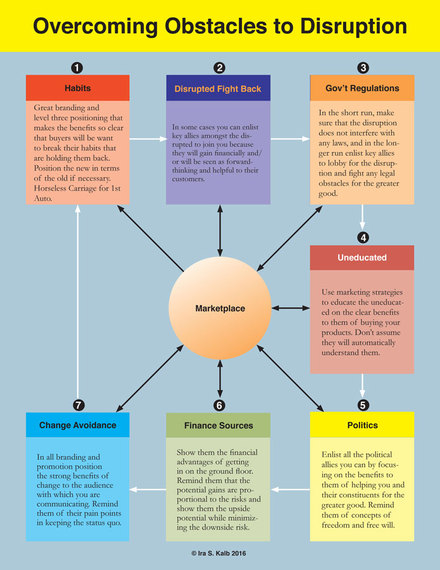This is the third post in my Creative Disruption trilogy. The first one provided strategies to protect your company from disruption. The second talked about the obstacles disrupters are likely to face when introducing a disruptive company, product, or technology. In this one, I focus on overcoming these obstacles so that companies can successfully introduce breakthrough products and technologies that improve lives and make the world a better place.
Overcoming the habit obstacle
Penetrating the habit obstacle is rarely trivial or easy. Even so, it is usually not that difficult if you appreciate the difficulty of the task, know your marketplace sufficiently well, and employ the strategies and tools required. There are three big steps that can take you to the place you want to go.
Step One. To overcome well-ingrained habits, the first step is to identify important needs that are not being filled. To do this, organizations need to do market research as part of their marketing information system strategies.
Step Two. Create a brand that (1) identifies the target audience with the unfilled needs (I call this the "lock" component of positioning) and (2) develops an image of the product that fills those needs better than competitors (I call this the "key" component of positioning to complete the lock and key metaphor). With the right key, the company can find an effective and memorable shortcut into the brains of the target audience.
Step Three. Communicate the brand benefits to the target audience using effective promotion strategies. To be effective, promotions have to have (1) compelling content, (2) be inserted into the right media the target audience consumes, (3) at the right times, and (4) within the promotion budget available.
Reducing the push back from the disrupted
After you have the right keys for the right locks and communicate effectively, you will be well on your way to getting your target audience to change its habits and try your products. If your products meet or exceed the expectations you set in your branding, customers and prospects will help you fight the inevitable battles you will face with those that are disrupted. Of course, you can help your own case if you develop a strategy that demonstrates how competitors that feel threatened can benefit from your creations. There are several ways you can do this.
- Convince them they need to change to survive. Convince them that the changes you are introducing are inevitable as technology advances. If you do not introduce these advances, others will. The sooner the disrupted make adjustments to focus on what they do better, the better off they will be. Since Uber entered the transportation market, taxicab companies upgraded their vehicles and procedures to better compete. Travel agencies that successfully weathered the Internet storm are those that offered unique curated trips that travelers could not easy find on the Internet.
Overcoming Government obstacles
Governments feel compelled to protect their constituents. They are less comfortable with disruptive products since they do not have a track record of safety. Focusing on the compelling benefits of your creative disruption that will make the lives of their constituents better can quiet these concerns. You have to look at marketing to government decision makers as an essential component in your marketing strategy. Uber has run afoul of some governments because the company did not address the concerns of groups that feel threatened by Uber. As a result, many cities around the world have prohibited Uber from operating.
Uneducated obstacles
Similar to the strategies you employed to overcome habits, you have to use marketing information system, branding, and promotion strategies to educate buyers and resellers of your products on the unique benefits your product provides them.
When the automobile was introduced, very few knew or understood the term. To get buyers and sellers in the marketplace to understand what an automobile was, manufacturers were compelled to express the new invention in terms of the older technology it replaced. Therefore, they called early automobiles horseless carriages until such time and the marketplace was comfortable with the new term.
When Apple introduced the iPhone, they formed an exclusive reseller relationship with ATT. This limited their distribution for quite a while. Why was this necessary? Only ATT was willing to accept the stringent requirements Apple thought it needed to be successful in the mobile phone business. Once the marketplace became educated on the unique benefits of the iPhone, the other big resellers - Verizon, T-Mobile, and Sprint were eager to add the iPhone since they all lost significant business from not having the iPhone in their product offerings.
Politics
Politics can stifle new inventions that disrupt older businesses. When the oil industry was in its infancy, it convinced those in positions of power that it needed incentives to survive, grow, and thrive. As a result, Government subsidies to the oil industry have been in place since 1916 and are estimated to be between $4 and $52 billion annually. The worldwide figure is pegged between $775 billion and $1 trillion. Many believe that at least some of these subsidies should be diverted to renewal energy sources so that they have the same infancy protection the oil industry had. To date, the lack of such subsidies is often cited as a reason why alternative energy sources have been slow to develop.
Through Tesla and Solar City, Elon Musk has been making a valiant effort to overcome political obstacles. He has had some small victories with positive reviews of his Model S Tesla, a large backlog for the Model 3, and the fact that several automakers are now offering high-powered electric automobiles. He might be further along if he employed a bigger arsenal of marketing strategies to overcome political barriers erected by entrenched forces in the fossil fuel and automobile industries.
Financing sources
The same marketing strategies needed to overcome habits and government barriers should be employed to clear financing hurdles. To get financing in early stages, disruptive companies have to use their own funds, crowdfunding, friends and family, or find angel investors. In addition to good branding and communications, smart money people often cite determination and belief in your product near the top of the list of reasons why they decide to invest in a business.
Change avoidance
To overcome the change avoidance obstacle, it is important to translate the benefits or your breakthrough products into tangible time and money components. Everyone understands time and money. If you can show how your product or technology will do that, you can get most people to buy what you are selling.
Disruption made easier
While it is never easy, creative disruption can work really well when you translate the benefits into terms that just about everyone can understand. This "everyone" group can include: purchase initiators, funders, referral sources, influencers, decision makers, buyers, resellers, users, and disposers. Even though one person can perform any number of these roles and some roles may overlap, the more of them you identify and consider in your marketing, the more your "creatively disruptive" product is likely to succeed.
Once the prospective buyers and referral sources are identified using your marketing information system, you need to craft compelling branding and communication strategies to overcome the inevitable barriers to your creative disruptions. If you get it right, the payoff can be huge as it has been for Google, Facebook, Netflix, and Apple. Best of luck.


